 INVESTOR PRESENTATION October 2012 Exhibit 99.1 |
 This presentation contains “forward-looking statements” within the meaning of the safe harbor from civil liability provided for such statements by the Private Securities Litigation Reform Act of 1995 (set forth in Section 27A of the Securities Act of 1933, as amended, or the Securities Act, and Section 21E of the Securities Exchange Act of 1934, as amended, or the Exchange Act). In particular, statements pertaining to our capital resources, portfolio size, quality and performance, dividend policy and results of operations contain forward-looking statements. Forward-looking statements involve numerous risks and uncertainties and you should not rely on them as predictions of future events. Forward-looking statements depend on assumptions, data or methods which may be incorrect or imprecise and we may not be able to realize them. We do not guarantee that the transactions and events described will happen as described (or that they will happen at all). You can identify forward-looking statements by the use of forward-looking terminology such as “believes,” “expects,” “may,” “should,” “seeks,” “intends,” “plans,” “pro forma,” “estimates,” “focus,” “contemplates,” “aims,” “continues,” “would” or “anticipates” or the negative of these words and phrases or similar words or phrases. You can also identify forward-looking statements by discussions of strategies, plans or intentions. The following factors, among others, could cause actual results and future events to differ materially from those set forth or contemplated in the forward-looking statements: general economic, business and financial conditions, and changes in our industry and changes in the real estate markets in particular; adverse economic and other developments in the Dallas-Fort Worth-Arlington area, where we have a high concentration of properties; general volatility of the capital and credit markets and the demand for and market price of our Class A common stock; changes in our business strategy; defaults on, early terminations of or non-renewal of leases by tenants; bankruptcy or insolvency of a major tenant or a significant number of smaller tenants; increased interest rates and operating costs; declining real estate valuations and impairment charges; availability, terms and deployment of capital; our failure to obtain necessary outside financing; our expected leverage; decreased rental rates or increased vacancy rates; our failure to generate sufficient cash flows to service our outstanding indebtedness; difficulties in identifying properties to acquire and completing acquisitions; risks of real estate acquisitions, dispositions and redevelopment, including the cost of construction delays and cost overruns; our failure to successfully operate acquired properties and operations; our projected operating results; our ability to manage our growth effectively; our failure to successfully redevelop properties; our ability to successfully transition certain corporate office functions from related parties to third parties or to us; estimates relating to our ability to make distributions to our shareholders in the future; impact of changes in governmental regulations, tax law and rates and similar matters; our failure to qualify as a REIT; future terrorist attacks in the U.S.; environmental uncertainties and risks related to natural disasters; lack or insufficient amounts of insurance; availability of and our ability to attract and retain qualified personnel; retention of our senior management team; our understanding of our competition; changes in real estate and zoning laws and increases in real property tax rates; our ability to comply with the laws, rules and regulations applicable to companies; and other risk factors, including those detailed in the sections of our most recent form 10-K and form 10-Q filed with the SEC titled “Risk Factors.” You should not place undue reliance on any forward-looking statements, which are based only on information currently available to us (or to third parties making the forward-looking statements). We undertake no obligation to publicly release any revisions to such forward-looking statements to reflect events or circumstances after the date of this presentation, except as required by applicable law. All information presented as of 6/30/12, unless otherwise noted 2 Disclaimer |
 Large, diversified, high quality retail portfolio Significant ability to enhance portfolio value through continued lease-up Diversified base of value-oriented retail tenants Capital structure positioned for growth Opportunity to enhance portfolio and balance sheet through dispositions of non-core and non-strategic assets Attractive dividend yield of 5.9%¹ Experienced management team with proven track record Executing a strategic growth plan to strengthen the Company’s retail Executing a strategic growth plan to strengthen the Company’s retail portfolio, improve its balance sheet, and portfolio, improve its balance sheet, and streamline its operating platform streamline its operating platform 1 Based on September 28, 2012 closing price of $11.32 and an annualized dividend of $0.6625 per share based on second quarter dividend of $0.165625 per share. Each dividend is determined quarterly by the Company’s Board of Directors, at its discretion 3 Investment Highlights |
 Enhancing portfolio value. Continuing to grow value through: — Strong leasing momentum — Stabilized cash flows — Active asset management focused on risk mitigation and tenant retention Strengthening balance sheet. Reducing leverage and overall risk profile is a top priority: — Successfully raise capital — Execute strategic disposition program Streamlining operating platform. Further enhance corporate governance: — Terminated the majority of our service agreements with The Inland Group — Achieved fully independent Board of Directors (excluding an executive director) — Relocating corporate headquarters off The Inland Group campus by year-end 4 Foundations of Strategic Growth Plan RPAI is working to deliver enhanced stockholder value and to position the Company for long-term success |
 Aon lease renewal — Active approach to asset management resulted in lease extensions and prepared the asset for sale Sold $227 M of assets YTD, most notably: — Mervyns 13-asset portfolio for $100 M, with proceeds used to repay the mortgage debt related to the 23-asset portfolio — Cost Plus for $63 M, which reduced our non-core GLA by approximately 25% Addressed all remaining 2012 debt maturities, as of October 1, 2012 Achieved fully independent Board of Directors (excluding an executive director), and separation from The Inland Group through service agreement terminations and headquarters move Russell 1000 index inclusion in June 2012 5 Execution of strategic initiatives lead to path for growth Execution of strategic initiatives lead to path for growth and sustainability and sustainability Executing Strategic Initiatives |
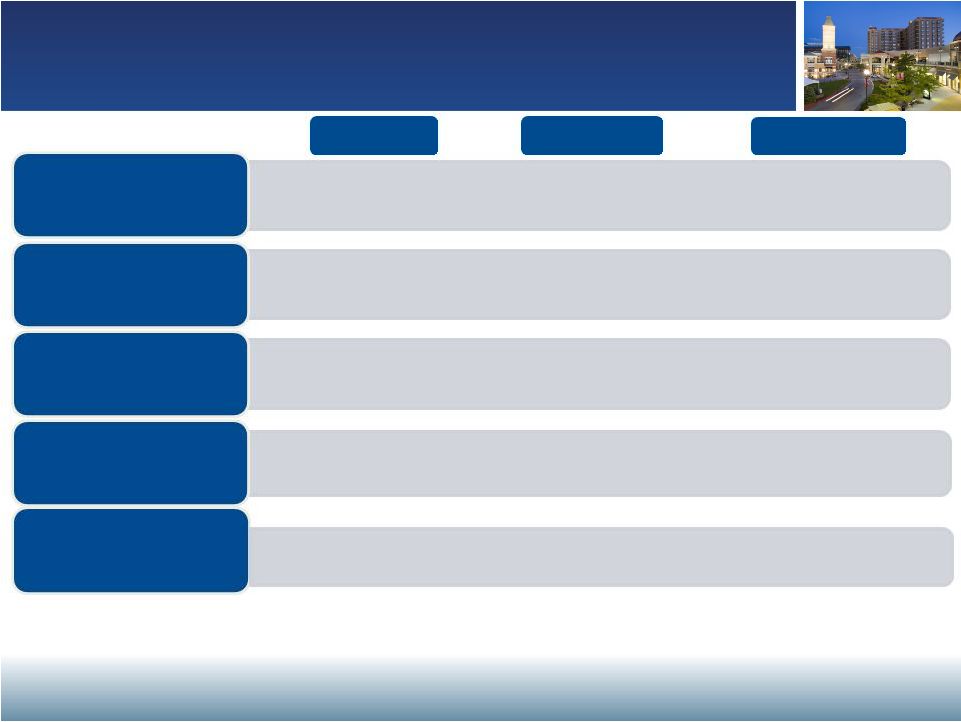 Financial and Operational Goals 89.0% 90.6%¹ 94% - 95% 4.1%³ 0.7%² 2% at stabilized occupancy² Less than 10% secured debt per year Goal 2 Quarter 2012 Year End 2008 16% 27% 1 2.2 million square feet of GLA was returned via big box retailer bankruptcies during 2009 2 Annual, year-over-year growth rate 3 Quarterly, year-over-year growth rate 4 Ratio is as of December 31, 2009, the first period for which the metric was reported 7.6x Reduce Combined Net Debt to EBITDA to 6.0 – 7.0x 8.9x 4 6 Strong results represent a foundation for growth Strong results represent a foundation for growth Drive occupancy Grow same store NOI Reduce leverage Create staggered debt maturity profile Reduce share of non- core assets (ABR%) 0% 18% 9% nd |
 Reported 2Q12 Operating FFO of $0.23 per share Reported same store NOI growth of +4.1% YOY Increased retail portfolio percent leased 230 bps YOY to 91.0% and increased retail portfolio occupancy 180 bps YOY to 88.1% Executed 148 new and renewal retail leases for 707,000 square feet of space Executed strategic lease renewal with Aon for 819,000 square feet of office space Generated positive comparable cash leasing spreads, including pro rata share of unconsolidated joint ventures, of 7.5% on new leases and 4.3% on renewal leases, for a blended spread of 5.0% Strong 2Q12 Financial & Operational Performance 7 Positive results reflect successful implementation Positive results reflect successful implementation of strategic plans of strategic plans |
 Asset Type Estimated Closing Estimated Sale Proceeds Year-to-date Q3¹ Various Closed $227 M Remaining Mervyns Assets Single-tenant retail Q4 $52 M - $72 M Aon Office Building Non-core office Q4 $145 M - $160 M Other Various Q4 $24 M - $91 M Total $450 M - $550 M 1 Includes pad sales, earnouts, and the GMAC deed-in-lieu transaction 2012 disposition program includes $450 - $550 M of non-core and non-strategic dispositions, of which $227 M has closed year-to-date Refocusing RPAI on multi-tenant retail through the anticipated dispositions of its largest industrial asset, its largest office asset, and over half of its single-tenant retail portfolio Estimated net proceeds of $200 - $300 M will further de-lever balance sheet and improve risk profile 8 Non-Core and Non-Strategic Disposition Program Strengthening Balance Sheet |
 •Only 13.2% ¹ of our retail annualized base rent expires before 2014 •Renewed approximately 76% of expiring leases since beginning of 2009 Stable cash flows •Currently operating at a historically wide spread between occupancy and percent leased rate —Spread at June 30, 2012 was 290 bps, up 50 bps year-over-year — Strong leasing momentum •Consolidated retail operating portfolio percent leased of 91.0%² as compared to 96.9%³ as of December 31, 2007 •The successful re-tenanting of big box space has allowed for renewed focus on small shops, which represent 1.7 million square feet, or approximately 490 bps of potential occupancy across the retail operating portfolio —94.5% leased on space over 10,000 square feet —81.3% leased on space under 10,000 square feet •Over 800,000 square feet of additional space in leasing pipeline Substantial lease-up opportunity •Focus on value enhancing strategies such as risk mitigation, tenant retention, long-term capital planning and asset sustainability initiatives •Disciplined capital recycling through the disposition of non-core and non-strategic assets Active asset management 1 Includes our pro rata share of unconsolidated joint ventures 2 Includes leases signed but not commenced 3 Includes only leases commenced Positioning RPAI for long-term value creation Positioning RPAI for long-term value creation 9 Enhancing Portfolio Value Maximizing NOI Through Internal Growth 1,013,000 square feet of newly signed leases, representing $12.9 M of contractually obligated ABR, have not yet commenced |
 Over 800,000 square feet in the leasing pipeline, consisting of 550,000 square feet of anchor transactions and over 250,000 square feet of small shop transactions Note: Consolidated retail operating portfolio; includes new and renewal leases Robust leasing pipeline driving improving occupancy rate Robust leasing pipeline driving improving occupancy rate 10 Capitalizing on Substantial Lease-up Opportunity Enhancing Portfolio Value 1,503 1,352 3,085 3,171 4,121 1,424 416 426 593 545 522 286 0 200 400 600 800 1,000 1,200 1,400 1,600 0 500 1,000 1,500 2,000 2,500 3,000 3,500 4,000 4,500 2007 2008 2009 2010 2011 YTD Q2 2012 Leased square feet Leases signed Leasing pipeline contains almost 200,000 square feet of fully negotiated LOI’s 11 prospective tenants are in negotiations for multiple spaces |
 Continuing to focus on controlling costs and corporate overhead Terminating a majority of service agreements with The Inland Group, including: — Investment advisory and mortgage servicing — Communication services — Insurance & risk management services — Property tax services — Personnel services — Technology services Signed lease for new office space and will move off The Inland Group campus by year-end All non-executive Directors are qualified as independent, as of May 2012 Corporate Governance Enhancements Streamlining Operating Platform 11 Committed to developing and maintaining integrated Committed to developing and maintaining integrated best-in-class real estate platform best-in-class real estate platform |
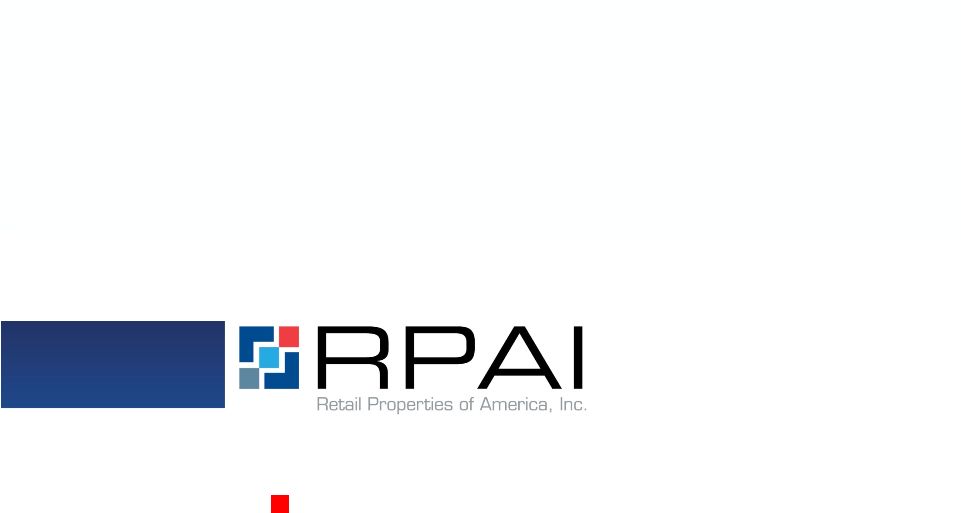 Company Overview 12 |
 259 Number of properties Consolidated retail operating property summary 34.9 M square feet Gross leasable area (GLA) Location 35 states Average portfolio age ~10 years Occupancy / percent leased 88.1% / 91.0%¹ Annualized base rent (ABR)² $434.2 M / $447.1 M¹ ABR per square foot² $14.13 / $14.09¹ Breakdown based on GLA Number of tenants ~1,500 Tenants Largest tenant 3.3% of ABR Non-retail portfolio based on ABR 11 office and 3 industrial properties 13 Power Center 45% Community/Neighborhood Center 36% Lifestyle Center 9% Single User 10% Non-retail 8.5% Retail 91.5% Includes leases signed but not commenced for approximately 1,013,000 square feet of GLA representing $12.9 M of annualized base rent at lease commencement ABR excludes $1.4 million from our development properties and $0.4 M for rental abatements for the 12 months ending June 30, 2013 1 2 RPAI at a Glance |
 Large Diversified Retail Portfolio High geographic diversity Strong multi-tenant 3-mile demographics in top 50 MSAs Significant presence in top MSAs Breakdown based on GLA 68% of multi-tenant ABR located in top 50 Metropolitan Statistical Areas (MSAs) FL Gross Leasable Area (GLA) More than 5mm sq.ft. 1–5mm sq.ft. Less than 1mm sq.ft. 2.9mm sq.ft 7.1mm sq.ft. 1.8mm sq.ft. 1.6mm sq.ft. 2.3mm sq.ft. Strategically located assets diversified by geography, retail property type, Strategically located assets diversified by geography, retail property type, and tenant base and tenant base 14 Power Center 45% Top 50 MSAs 68% Other MSAs 32% Single User 10% Community / Neighborhood Center 36% Lifestyle Center 9% — Best Buy, Target, Home Depot, Kohl’s, Wal-Mart, Lowe’s; or — A national or regional grocer Over 90% of multi-tenant assets located in markets outside of the top 50 MSAs are anchored by: — Average population of 89,626 — Expected population growth of 6.6% over the next five years — Average household income of $83,152 |
 Power center – Summerville, SC GLA: 272,000 sq.ft. Occupancy: 99.2% ABR per leased sq.ft.: $13.44 Community center – Newport News, VA GLA: 308,000 sq.ft. Occupancy: 95.0% ABR per leased sq.ft.: $17.11 Community center – Denton, TX GLA: 339,000 sq.ft. Occupancy: 96.8% ABR per leased sq.ft.: $14.58 Lifestyle center – Southlake, TX GLA: 840,000 sq.ft. Occupancy: 86.5% ABR per leased sq.ft.: $28.37 Power center – Temecula, CA GLA: 293,000 sq.ft. Occupancy: 96.3% ABR per leased sq.ft.: $12.48 Community center – Chicago, IL GLA: 261,000 sq.ft. Occupancy: 95.4% ABR per leased sq.ft.: $21.56 Power center – Seattle, WA GLA: 303,000 sq.ft. Occupancy: 97.3% ABR per leased sq.ft.: $11.96 Lifestyle center – Plano, TX GLA: 391,000 sq.ft. Occupancy: 88.2% ABR per leased sq.ft.: $25.74 Southlake Town Square Denton Town Crossing Commons at Temecula Northgate North The Brickyard Azalea Square Jefferson Commons Shops at Legacy Note: Occupancy figures represent economic occupancy 15 Representative Properties |
 National Platform with Local Focus Client-focused organization with significant local and regional on-the-ground presence 19 strategically located property management offices Over 180 employees dedicated to operations, including over 80 property managers and senior leasing agents with an average of 15 years experience in the industry GLA (000s sq.ft.) Regional breakdown 10,627 7,589 8,617 8,040 ABR ($000s) $136,764 103,486 101,787 92,134 Total 34,873 $434,171 Note: Reflects consolidated retail operating portfolio Experienced and talented employee base Experienced and talented employee base with nationwide coverage with nationwide coverage West East South North 16 |
 1 Represents retail operating portfolio including our pro rata share of unconsolidated joint ventures Rank Tenant # of Stores GLA(000s) ABR(000s) % of Retail ABR 1 Best Buy Co, Inc. 30 1,069 $ 14,568 3.3% 2 Ahold USA, Inc. 11 661 12,935 2.9% 3 The TJX Companies Inc. 47 1,242 11,770 2.6% 4 Rite Aid Corporation 35 425 10,399 2.3% 5 PetSmart, Inc. 39 707 9,821 2.2% 6 Ross Stores, Inc. 38 990 9,448 2.1% 7 Bed Bath & Beyond Inc. 28 726 9,232 2.1% 8 The Home Depot, Inc. 9 1,097 9,135 2.0% 9 Kohl's Corporation 14 1,143 8,095 1.8% 10 The Sports Authority, Inc. 17 690 7,952 1.8% 11 Supervalu Inc. 10 562 7,705 1.7% 12 Pier 1 Imports, Inc. 39 390 7,252 1.6% 13 Publix Super Markets Inc. 15 634 6,703 1.5% 14 Michaels Stores, Inc. 29 588 6,592 1.5% 15 Edwards Theaters, Inc. 2 219 6,558 1.5% 16 Dicks Sporting Goods, Inc. 13 568 6,525 1.5% 17 Wal-Mart Stores, Inc. 6 903 5,985 1.3% 18 Office Depot, Inc. 22 439 5,737 1.3% 19 Staples, Inc. 18 342 4,663 1.0% 20 Rave Cinemas, LLC 2 162 4,626 1.0% Total 424 13,557 $165,701 37.0% Approximately 1,500 tenants with approximately 3,200 leases 32 tenants each lease space at more than 15 of our locations, representing 8.8 M square feet Over 90% of our shopping centers anchored or shadow-anchored by retailers selling basic household goods or clothing Shadow anchors provide additional stability and traffic generation — For example, we have 43 Target, 18 Home Depot and 13 Wal- Mart shadow anchors Diversity reduces risk of overexposure Diversity reduces risk of overexposure 17 Diversified Base of Value-Oriented Retail Tenants Top 20 retail tenants represent 37% of retail ABR 1 |
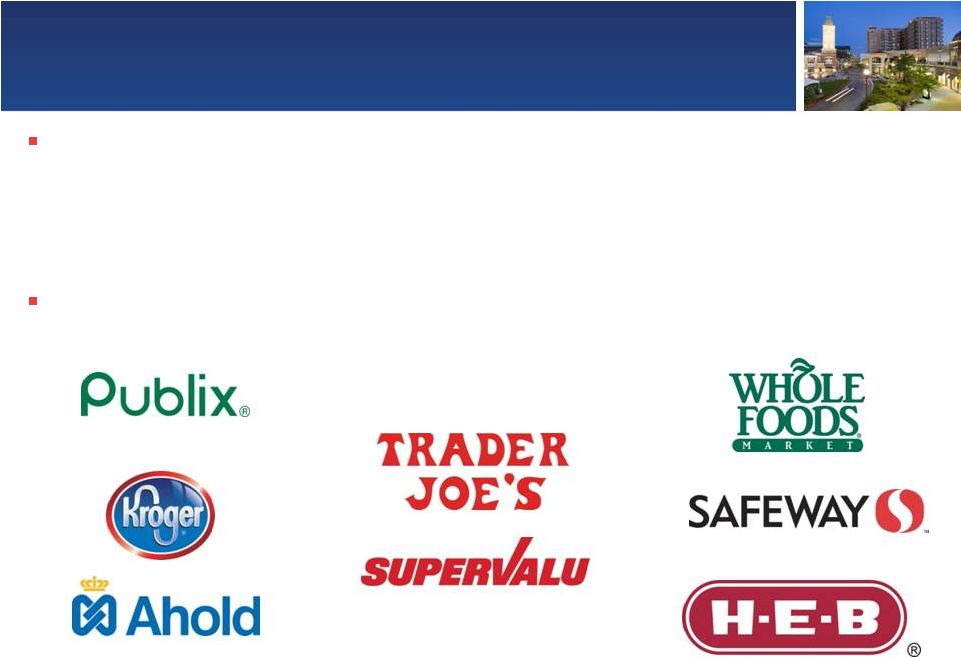 Portfolio has strong line-up of grocery anchors — 74 of our 196 multi-tenant retail properties 1 are anchored or shadow-anchored by a grocery store, and an additional 48 properties have a non-traditional grocery component 2 Annual grocer sales average $25 M 3 or $501 per square foot, translating into an estimated 18,000 4 shopper visits per week 1 Includes wholly-owned and unconsolidated joint ventures 2 Non-traditional component is defined as stores containing a Wal-Mart or Target branded location 3 Includes only tenants that report sales 4 Estimate of shopper visits based on $26.78 sales per customer transaction (source: www.fmi.org “FMI Facts & Figures”) 18 Dominant Grocery Anchors Drive Traffic |
 CAPITAL MARKETS 19 |
 Raised $293 M of common equity and began trading on the NYSE in early April Closed a new $650 M unsecured credit facility in February, comprised of a $350 M revolver and a $300 M term loan — Available borrowings can increase to $850 M in certain circumstances — In 3Q12, we entered into an interest rate swap transaction to fix the variable rate portion of the term loan at 0.54% through February 2016 (spread on the line of credit was 2.50%, as of June 30, 2012) Originated ten mortgages totaling $281 M at a weighted average interest rate of 4.53% and a weighted average term of 9.4 years As of October 1, 2012, addressed all remaining 2012 debt maturities Providing financial flexibility to enhance balance sheet Providing financial flexibility to enhance balance sheet and position RPAI for growth and position RPAI for growth 20 Strengthening Balance Sheet Over $1.2 B of Capital Raised in 2012 |
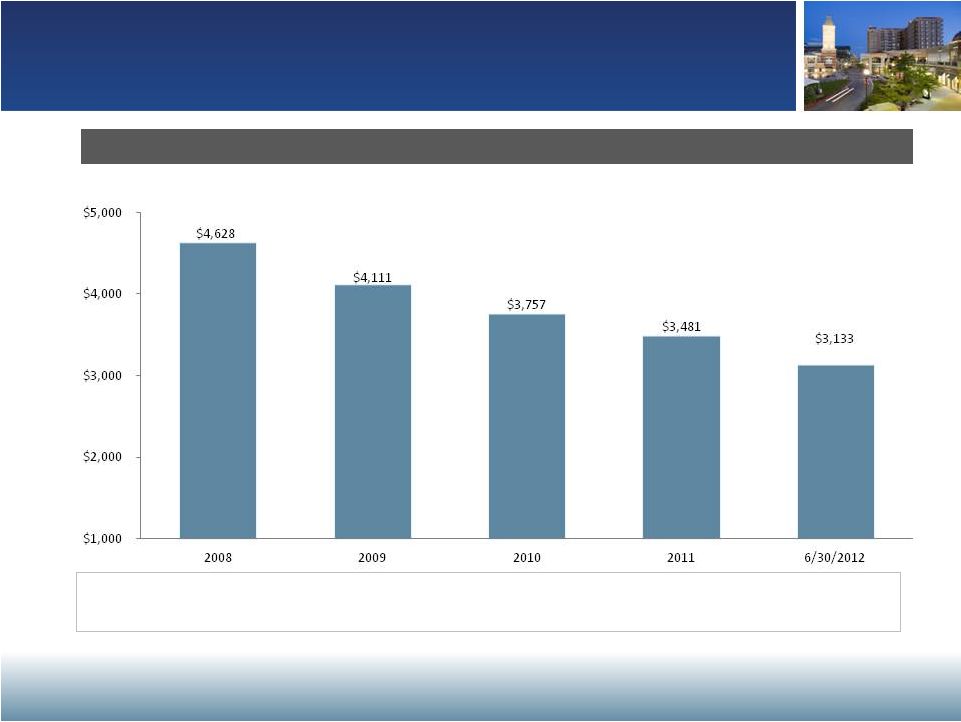 Historical Leverage Profile Total Consolidated Debt ($M) Combined Net Debt / Combined Adjusted EBITDA 8.9x 8.5x 7.6x 8.3x Improving our risk profile by reducing leverage Improving our risk profile by reducing leverage is a top priority is a top priority 21 |
 Capital Structure Positioned for Growth Amount Interest Capitalization ($M) Credit statistics $130 Unsecured Revolving Line of Credit 2.75% 300 Unsecured Term Loan 2.75% 2,562 Mortgage Debt 6.03% 139 Mezzanine Debt 12.62% 2 Margin Debt 1.74% $3,133 Total Debt 5.87% (102) Less Cash $3,031 Net Debt Combined Net Debt to Combined Adjusted EBITDA 7.6x Fixed Rate Debt 85.2% Weighted Average Maturity 5.5 years Weighted Average Interest Rate 5.87% Strong liquidity position, with $102 M of cash and $220 M of availability on the unsecured line of credit at June 30, 2012 Additional deleveraging is expected to come from the continued lease-up of the portfolio and the execution of the non-core and non-strategic disposition program Objective of becoming an investment grade borrower Objective of becoming an investment grade borrower 22 1 1 2 1 Subsequent to quarter end, we entered into an interest rate swap transaction to convert the variable portion of $300 million of floating rate debt to a fixed rate of 0.54% through February 2016. As a result, the all-in interest rate on the term loan would have been 3.04% and our fixed rate debt would have comprised 95% of our total debt 2 $14 million of mezzanine debt was repaid on July 2, 2012. The remaining $125 million of mezzanine debt is open for prepayment in 1Q13, subject to a prepayment penalty |
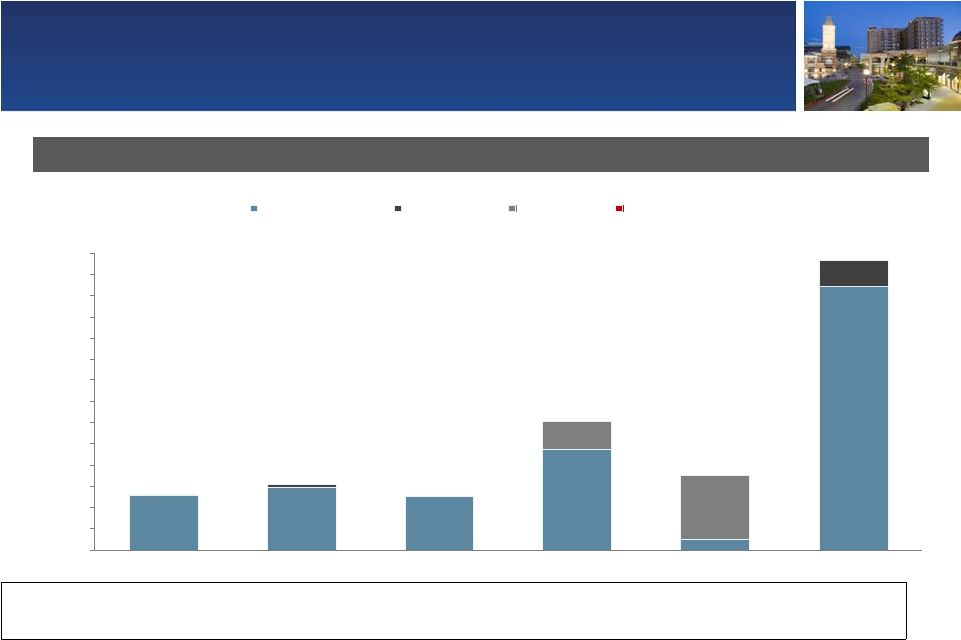 Debt Maturity Profile ($M) $258 8.2% $307 9.8% $251 8.0% $602 19.2% $349 11.1% $1,367 43.7% Weighted average interest rate 5.67% 5.48% 6.90% 5.11% 3.20% 6.83% Note: Excludes mortgage discount of $1.7 million, as of 6/30/2012 23 $0 $100 $200 $300 $400 $500 $600 $700 $800 $900 $1,000 $1,100 $1,200 $1,300 $1,400 2012 2013 2014 2015 2016 Thereafter Mortgages payable Notes payable Credit facility Margin payable Manageable Near-Term Debt Maturities |
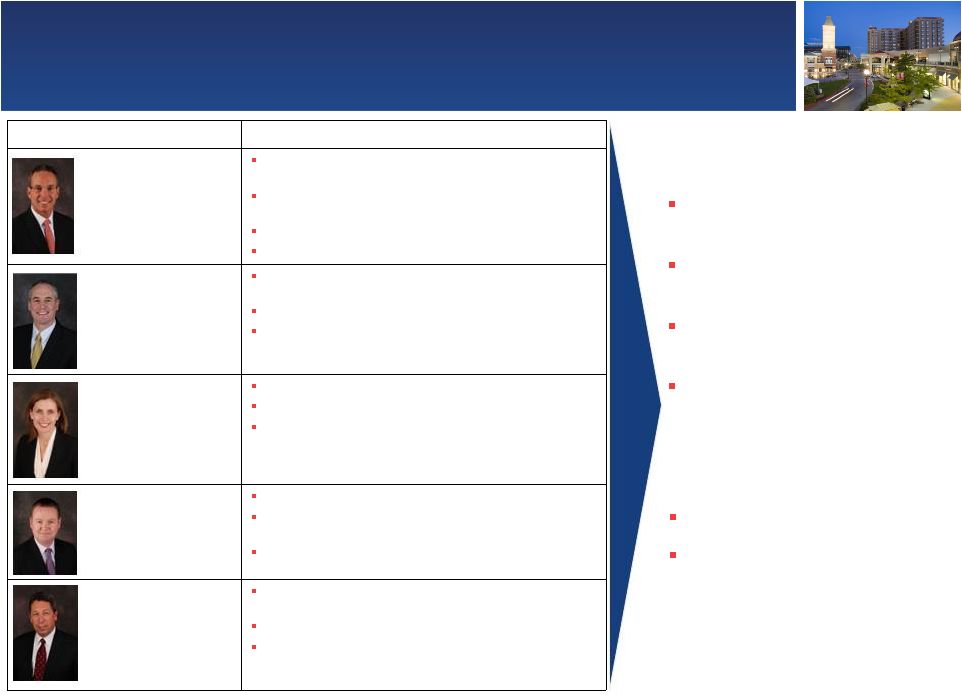 Experienced Management Team Executive Experience Steven P. Grimes President & Chief Executive Officer Former experience as Chief Operating Officer & Chief Financial Officer Director with the mortgage brokerage firm of Cohen Financial Senior Manager with Deloitte & Touche Named to the Board in March 2011 Shane C. Garrison EVP Chief Operating Officer & Chief Investment Officer Vice President of Asset Management of RPAI US Management LLC Head of Asset Management for ECI Properties General Manager of the Midwest region for Circuit City Angela Aman EVP Chief Financial Officer & Treasurer Former Director of Capital Markets Portfolio Manager at RREEF Investment Banker for Deutsche Bank Niall J. Byrne EVP & President of Property Management Senior Vice President of RPAI Holdco Management LLC Vice President of Asset Management of American Landmark Properties, Ltd. Senior Vice President / Director of Operations for Providence Management Company, LLC Dennis K. Holland EVP General Counsel & Secretary Associate Counsel for The Inland Real Estate Group, Inc. Deputy General Counsel with Heller Financial, Inc. Subsequently employed by GE Capital following the acquisition of Heller Financial Average 22+ years of real estate industry experience Successfully navigated most recent economic crisis Senior executive focus on operations In-house management and leasing Dedicated Management Team Board elected annually All non-management board members are independent Board of Directors 24 |
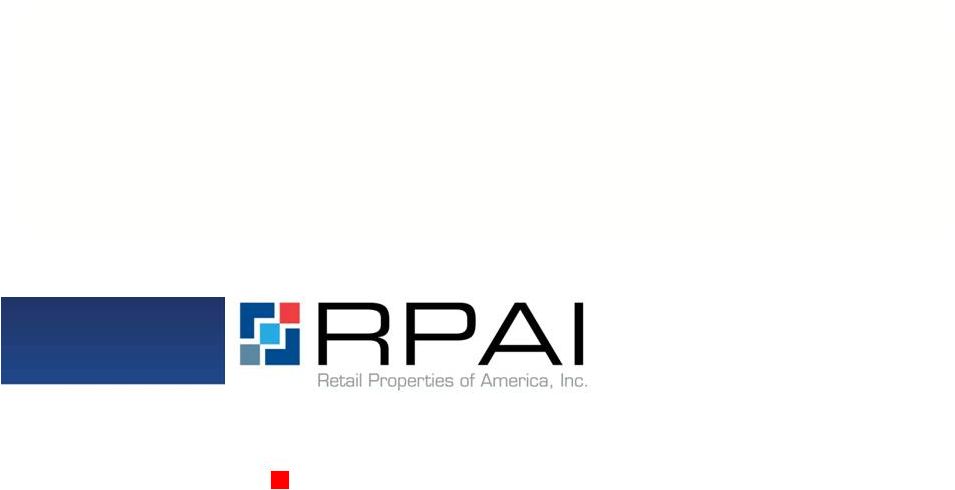 APPENDIX NON-GAAP RECONCILIATIONS 25 |
 Non-GAAP Financial Measures A-1 A-1 As defined by the National Association of Real Estate Investment Trusts (NAREIT), an industry trade group, Funds from Operations (FFO) means net (loss) income computed in accordance with generally accepted accounting principles (GAAP), excluding gains (or losses) from sales of investment properties, plus depreciation and amortization and impairment charges on investment properties, including adjustments for unconsolidated joint ventures in which we hold an interest. We have adopted the NAREIT definition in our computation of FFO and believe that FFO, which is a non-GAAP performance measure, provides an additional and useful means to assess the operating performance of real estate investment trusts (REITs). We believe that, subject to the following limitations, FFO provides a basis for comparing our performance and operations to those of other REITs. FFO is not intended to be an alternative to "Net Income" as an indicator of our performance, nor an alternative to "Cash Flows from Operating Activities" as determined by GAAP as a measure of our capacity to pay distributions. Depreciation and amortization related to investment properties for purposes of calculating FFO include loss on lease terminations, which encompasses the write-off of tenant-related assets, including tenant improvements and in-place lease values, as a result of early lease terminations. Loss on lease terminations included in depreciation and amortization for FFO excludes the write-off of tenant-related above and below market lease intangibles that are otherwise included in "Loss on lease terminations" in our condensed consolidated statements of operations. Operating FFO is defined as FFO excluding the impact of gains and losses from the early extinguishment of debt and other items as denoted within the calculation that we do not believe are representative of the operating results of our core business platform. We consider Operating FFO a meaningful, additional measure of operating performance primarily because it excludes the effects of transactions and other events which we do not consider representative of the operating results of our core business platform. Operating FFO does not represent an alternative to "Net Income" as an indicator of our performance, nor an alternative to "Cash Flows from Operating Activities" as determined by GAAP as a measure of our capacity to pay dividends. Further, comparison of our presentation of Operating FFO to similarly titled measures for other REITs may not necessarily be meaningful due to possible differences in definition and application by such REITs. We define Net Operating Income (NOI) as operating revenues (rental income, tenant recovery income, other property income, excluding straight-line rental income, amortization of lease inducements and amortization of acquired above and below market lease intangibles) less property operating expenses (real estate tax expense and property operating expense, excluding straight-line ground rent expense and straight-line bad debt expense). We believe that is a useful measures of our operating performance. Other REITs may use different methodologies for calculating NOI, and accordingly, our NOI may not be comparable to other REITs. We believe that NOI provides an operating perspective not immediately apparent from GAAP operating income or net (loss) income. We use NOI to evaluate our performance on a property-by-property basis because these measures allow management to evaluate the impact that factors such as lease structure, lease rates and tenant base, which vary by property, have on our operating results. However, these measures should only be used as an alternative measure of our financial performance. As of June 30, 2012, Same Store NOI represents NOI from our Same Store portfolio consisting of 270 operating properties acquired or place in service prior to April 1, 2011. NOI from Other Investment Properties represents NOI primarily from our development properties, two additional phases of existing properties acquired during the third quarter of 2011, two non-stabilized operating properties and one property that was partially sold to our RioCan joint venture during the third quarter of 2011, which did not qualify for discontinued operations accounting treatment. In addition, we have included University Square, the property for which we have ceased making the monthly debt service payment and for which we have attempted to negotiate with the lender in “Other Investment Properties” due to the uncertainty of the timing of the transfer of ownership of this property. Prior to this quarter, we had included University Square in the Same Store portfolio. NOI consists of the sum of Same Store NOI and NOI from Other Investment Properties. The Same Store portfolio as of December 31, 2008 consisted of 294 operating properties acquired or placed into service prior to January 1, 2007. Adjusted EBITDA represents net income (loss) before interest, income taxes, depreciation and amortization, as further adjusted to eliminate the impact of certain items that we do not consider indicative of our ongoing performance. Combined Adjusted EBITDA represents Adjusted EBITDA plus our pro rata share of the EBITDA adjustments from our investment property unconsolidated joint ventures, including discontinued operations associated with those ventures. We believe that Adjusted EBITDA and Combined Adjusted EBITDA are useful because they allow investors and management to evaluate and compare our performance from period to period in a meaningful and consistent manner in addition to standard financial measurements under GAAP. Adjusted EBITDA and Combined Adjusted EBITDA are not measurements of financial performance under GAAP and should not be considered as alternatives to net income, as an indicator of operating performance or any measure of performance derived in accordance with GAAP. Our calculations of Adjusted EBITDA and Combined Adjusted EBITDA may be different from the calculation used by other companies and, accordingly, comparability may be limited. Net Debt to Adjusted EBITDA represents (i) our total debt less cash and cash equivalents divided by (ii) Adjusted EBITDA for the prior 12 months. Combined Net Debt to Combined Adjusted EBITDA represents (i) the sum of (A) our total debt less cash and cash equivalents plus (B) our pro rata share of our investment property unconsolidated joint ventures' total debt less our pro rata share of these joint ventures' cash and cash equivalents divided by (ii) Combined Adjusted EBITDA for the prior 12 months. We believe that these ratios are useful because they provide investors with information regarding total debt net of cash and cash equivalents, which could be used to repay debt, compared to our performance as measured using Adjusted EBITDA and Combined Adjusted EBITDA. Funds From Operation (FFO) Operating FFO Net Operating Income (NOI) Same Store NOI and NOI from Other Investment Properties Adjusted EBITDA and Combined Adjusted EBITDA Net Debt to Adjusted EBITDA and Combined Net Debt to Combined Adjusted EBITDA |
 Three Months Ended June 30, Twelve Months Ended December 31, (in thousands) 2012 2011 2008¹ 2007¹ Same Store investment properties $105,402 $101,252 $477,954 $474,628 Other investment properties 166 2,590 32,712 23,754 Total net operating income 105,568 103,842 510,666 498,382 Other income (expense): Straight-line rental income, net 228 (132) 12,851 15,882 Amortization of acquired above and below market lease intangibles, net 376 426 2,504 3,200 Amortization of lease inducements (72) (15) - - Straight-line ground rent expense (910) (948) (5,186) (3,806) Straight-line bad debt expense - - (8,749) (1,877) Insurance captive income - - 1,938 1,890 Depreciation and amortization (58,289) (58,742) (265,587) (257,132) Provision for impairment of investment properties (1,323) - (80,000) (13,560) Loss on lease terminations (1,177) (3,355) (67,092) (11,788) Insurance captive expenses - - (2,874) (1,598) General and administrative expenses (6,543) (5,043) (19,997) (16,535) Advisor asset management fee - - - (23,750) Dividend income 615 522 24,010 23,729 Interest income 19 170 4,329 13,671 Gain on extinguishment of debt, net - 3,715 - 2,486 Gain on contribution of investment properties - - - 11,749 Equity in (loss) income of unconsolidated joint ventures, net (1,286) (1,981) (4,939) 96 Interest expense (40,537) (55,644) (224,015) (217,771) Co-venture obligation expense (397) (1,792) - - Recognized gain (loss) on marketable securities, net 7,265 277 (160,888) (19,967) Impairment of goodwill - - (377,916) - Loss on investment in unconsolidated joint venture - - (5,524) - Loss on interest rate locks - - (16,778) - Other income/(expense), net 2,479 171 (1,062) 237 Total other expense (99,552) (122,371) (1,194,975) (494,844) Income (loss) from continuing operations 6,016 (18,529) (684,309) 3,538 Discontinued operations: Operating income, net 490 1,709 1,096 2,200 Gain on sales of investment properties, net 6,847 702 - 37,296 Income from discontinued operations 7,337 2,411 1,096 39,496 Gain on sales of investment properties 4,323 2,402 - - Net income (loss) 17,676 (13,716) (683,213) 43,034 Net income attributable to noncontrolling interests - (8) (514) (1,365) Net income (loss) attributable to Company shareholders $17,676 $(13,724) $(683,727) $41,669 1 Figures reflect properties in our same sore portfolio as of December 31, 2008 and properties that qualified as discontinued operations through December 31, 2008. Properties that have qualified as discontinued operations subsequent to December 31, 2008 are reflected in continuing operations A-2 Reconciliation of NOI to Net Income |
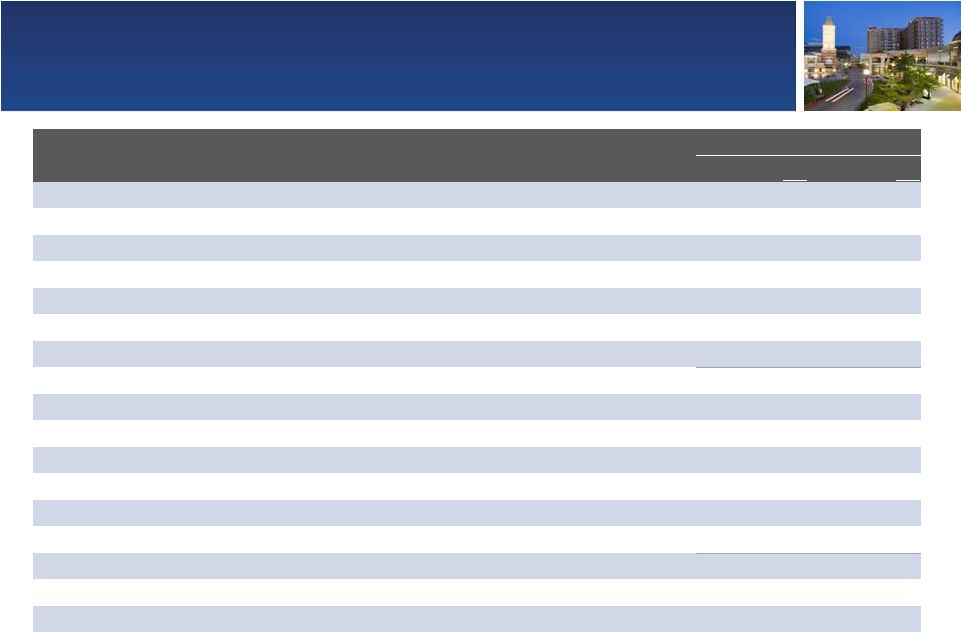 Three Months Ended June 30, (in thousands, except per share amounts) 2012 2011 Net income (loss) attributable to Company shareholders $17,676 $(13,724) Add: Depreciation and amortization¹ 62,156 64,389 Provision for impairment of investment properties¹ 1,498 1,523 Less: Gain on sales of investment properties¹ (11,170) (3,104) Non-controlling interests’ share of depreciation related to consolidated joint ventures¹ - (96) Funds from operations(FFO) $70,160 $48,988 FFO per common share outstanding $0.31 $0.25 Less: Mortgage premium write-off (10,295) - Recognized gain on marketable securities (7,265) (277) Gain on extinguishment of debt - (3,715) Other (1,627) - Operating FFO $50,973 $44,996 Operating FFO per common share outstanding $0.23 $0.23 Weighted average number of common shares outstanding 226,543 192,114 1 Includes amounts from discontinued operations A-3 Reconciliation of Operating FFO |
 Twelve Months Ended (in thousands) June 30, 2012 December 31, 2011 December 31, 2010 December 31, 2009 Net loss $(17,457) $(72,578) $(94,707) $(115,409) Interest expense 209,985 230,979 255,355 226,392 Interest expense (discontinued operations) 958 1,911 9,561 18,101 Depreciation and amortization 233,755 234,406 238,563 241,414 Depreciation and amortization (discontinued operations) 1,215 3,614 9,525 17,178 Loss on partial sales of investment properties - - 385 - Gain on sales of investment properties (5,846) (5,906) - - Gain on sales of investment properties, net (discontinued operations) (28,110) (24,509) (23,806) (26,383) Gain on extinguishment of debt, net (6,146) (16,705) - - Loss on lease terminations 7,621 9,704 15,523 17,550 Loss on lease terminations (discontinued operations) - 26 285 54 Provision for impairment of investment properties 8,973 7,650 11,030 27,600 Provision for impairment of investment properties (discontinued operations) 1,958 32,331 12,027 37,100 Impairment of notes receivable - - - 17,322 Recognized gain on marketable securities, net (7,265) (277) (4,007) (18,039) Gain on interest rate locks - - - (3,989) Adjusted EBITDA $399,641 $400,646 $429,734 $438,891 Pro rata share of adjustments from investment property unconsolidated joint ventures: Interest expense $3,863 $3,310 $2,804 $4,294 Depreciation and amortization 9,607 7,080 3,781 3,372 Loss (gain) on sales of investment properties 28 28 (432) 675 Loss on lease terminations 561 387 - - Provision for impairment of investment properties 1,292 3,959 - 9,062 Amortization of basis (not pro rata) 156 204 277 284 Combined Adjusted EBITDA¹ $415,148 $415,614 $436,164 $456,578 1 Combined data and ratios include our pro rata share of unconsolidated joint ventures in addition to our wholly-owned and consolidated portfolio A-4 Reconciliation of Combined Adjusted EBITDA |
 Period Ended (in thousands, except ratios) June 30, 2012 December 31, 2011 December 31, 2010 December 31, 2009 Total debt $3,132,920 $3,481,218 $3,757,237 $4,110,985 Less: cash and cash equivalents (102,346) (136,009) (130,213) (125,904) Net debt $3,030,574 $3,345,209 $3,627,024 $3,985,081 Adjusted EBITDA¹ 399,641 400,646 429,734 438,891 Net debt to Adjusted EBITDA 7.6x 8.3x 8.4x 9.1x Net debt $3,030,574 $3,345,209 $3,627,024 $3,985,081 Add: pro rata share of our investment property unconsolidated joint ventures’ total debt 112,071 114,382 79,475 62,998 Less: pro rata share of our investment property unconsolidated joint ventures’ cash and cash equivalents (2,157) (13,238) (1,527) (4,116) Combined net debt² $3,140,488 $3,446,353 $3,704,972 $4,043,963 Combined Adjusted EBITDA 1,2 415,148 415,614 436,164 456,578 Combined net debt to combined Adjusted EBITDA² 7.6x 8.3x 8.5x 8.9x 1 For purposes of these ratio calculations, twelve months ended figures were used 2 Combined data and ratios include our pro rata share of unconsolidated joint ventures in addition to our wholly-owned and consolidated portfolio A-5 Reconciliation of Combined Net Debt to Combined Adjusted EBITDA |
 |